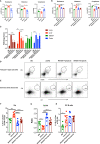Targeting the Retinoid X Receptor Pathway Prevents and Ameliorates Murine Chronic Graft-Versus-Host Disease
- PMID: 35359939
- PMCID: PMC8963714
- DOI: 10.3389/fimmu.2022.765319
Targeting the Retinoid X Receptor Pathway Prevents and Ameliorates Murine Chronic Graft-Versus-Host Disease
Abstract
Most allogeneic hematopoietic stem cell transplant (allo-HSCT) recipients receive peripheral blood stem cell grafts resulting in a 30%-70% incidence of chronic graft-versus-host disease (cGVHD), a major cause of mortality and morbidity in long-term survivors. While systemic steroids remain the standard of care for first-line therapy, patients may require long-term administration, and those with steroid-resistant or refractory cGVHD have a worse prognosis. Although durable and deep responses with second-line therapies can be achieved in some patients, there remains an urgent need for new therapies. In this study, we evaluated the efficacy of IRX4204, a novel agonist that activates RXRs and is in clinical trials for cancer treatment to prevent and treat cGVHD in two complementary murine models. In a major histocompatibility complex mismatched, non-sclerodermatous multiorgan system model with bronchiolitis obliterans, IRX4204 prevented and reversed cGVHD including associated pulmonary dysfunction with restoration of germinal center T-follicular helper: T-follicular regulatory cell balance. In a minor histocompatibility antigen disparate sclerodermatous model, IRX4204 treatment significantly prevented and ameliorated skin cGVHD by reducing Th1 and Th17 differentiation due to anti-inflammatory properties. Together, these results indicate that IRX4204 is a promising therapeutic option to treat cGVHD with bronchiolitis obliterans or sclerodermatous manifestations.
Keywords: IL-17; RXR; TFH; TfR; germinal center B cells.
Copyright © 2022 Thangavelu, Zaiken, Mohamed, Flynn, Du, Rhee, Riddle, Aguilar, Panoskaltsis-Mortari, Sanders and Blazar.
Conflict of interest statement
BB receives remuneration as an advisor to Kamon Pharmaceuticals, Five Prime Therapeutics, Regeneron Pharmaceuticals, Magenta Therapeutics, and BlueRock Therapeuetics; research support from Fate Therapeutics, RXi Pharmaceuticals, Alpine Immune Sciences, Abbvie, the Leukemia and Lymphoma Society, the Children’s Cancer Research Fund, and the KidsFirst Fund and is a cofounder of Tmunity. Author MS is shareholder, officer, and director of the company Io Therapeutics, Inc., which is developing IRX4204 for commercialization.The reviewer DW has declared a past co-authorship with one of the authors BB at the time of review. The remaining authors declare that the research was conducted in the absence of any commercial or financial relationships that could be construed as a potential conflict of interest.
Figures



Similar articles
-
Targeting Bcl-6 prevents sclerodermatous chronic graft-versus-host disease by abrogating T follicular helper differentiation in mice.Int Immunopharmacol. 2023 Apr;117:109746. doi: 10.1016/j.intimp.2023.109746. Epub 2023 Feb 22. Int Immunopharmacol. 2023. PMID: 36827923
-
Increased T follicular helper cells and germinal center B cells are required for cGVHD and bronchiolitis obliterans.Blood. 2014 Jun 19;123(25):3988-98. doi: 10.1182/blood-2014-03-562231. Epub 2014 May 12. Blood. 2014. PMID: 24820310 Free PMC article.
-
Pirfenidone ameliorates murine chronic GVHD through inhibition of macrophage infiltration and TGF-β production.Blood. 2017 May 4;129(18):2570-2580. doi: 10.1182/blood-2017-01-758854. Epub 2017 Mar 2. Blood. 2017. PMID: 28254742 Free PMC article.
-
A critical review of belumosudil in adult and pediatric patients with chronic graft-versus-host disease.Expert Rev Clin Immunol. 2023 Mar;19(3):241-251. doi: 10.1080/1744666X.2023.2152330. Epub 2022 Nov 30. Expert Rev Clin Immunol. 2023. PMID: 36440483 Review.
-
Chronic graft-versus-host disease: biological insights from preclinical and clinical studies.Blood. 2017 Jan 5;129(1):13-21. doi: 10.1182/blood-2016-06-686618. Epub 2016 Nov 7. Blood. 2017. PMID: 27821504 Free PMC article. Review.
Cited by
-
The Inhibition of RXRα and RXRβ Receptors Provides Valuable Insights for Potential Prostate Cancer Treatment, in silico Molecular Docking and Molecular Dynamics Studies.Asian Pac J Cancer Prev. 2024 Jul 1;25(7):2329-2335. doi: 10.31557/APJCP.2024.25.7.2329. Asian Pac J Cancer Prev. 2024. PMID: 39068565 Free PMC article.
-
Deficiency of T follicular helper cell Tet3 DNA demethylation inhibits pathogenic IgG2c class switching and chronic GVHD.Blood. 2025 Jun 12;145(24):2813-2827. doi: 10.1182/blood.2024025036. Blood. 2025. PMID: 39899881
References
-
- Wolff D, Gerbitz A, Ayuk F, Kiani A, Hildebrandt GC, Vogelsang GB, et al. . Consensus Conference on Clinical Practice in Chronic Graft-Versus-Host Disease (GVHD): First-Line and Topical Treatment of Chronic GVHD. Biol Blood Marrow Transplant (2010) 16(12):1611–28. doi: 10.1016/j.bbmt.2010.06.015 - DOI - PubMed
-
- Martin PJ, Rizzo JD, Wingard JR, Ballen K, Curtin PT, Cutler C, et al. . First- and Second-Line Systemic Treatment of Acute Graft-Versus-Host Disease: Recommendations of the American Society of Blood and Marrow Transplantation. Biol Blood Marrow Transplant (2012) 18(8):1150–63. doi: 10.1016/j.bbmt.2012.04.005 - DOI - PMC - PubMed
MeSH terms
Substances
Grants and funding
LinkOut - more resources
Full Text Sources

